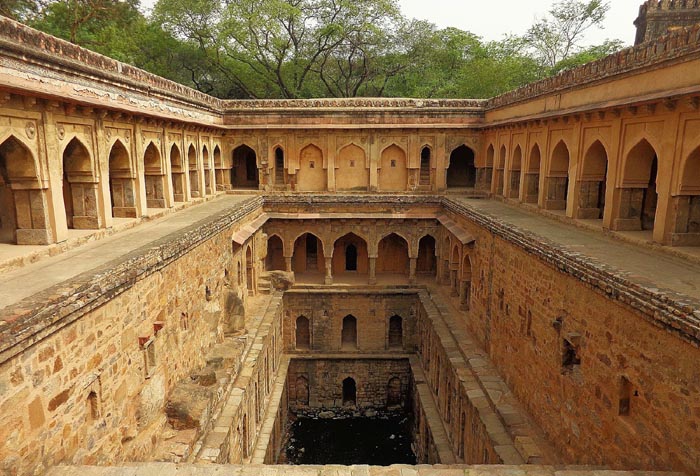Rajon Ki Bain

Information on Rajon Ki Bain (New Delhi) - History & Architecture
The Rajon Ki Bain is also alternatively known as Rajon Ki Baoli and is a popular step-well situated close to Adham Khan's Tomb in Mehrauli, Delhi. Delhi, regardless of its situation beside the famous river Yamuna, has at all times witnessed difficulties with respect to water supply. The issue of acute shortage of water arises partly due to the tremendously hot and long duration of summer and also for the nearness of the parched zones of adjoining Rajasthan and Harayana. The rulers of the city, Delhi were learnt to have triggered the initiation of setting up waterworks since the early days in the form of canals, wells, dams and artificially made lakes. Among the mentioned form of water reservoirs, one of the most well-known was the step-wells or baolis.
Rajon Ki Bain Architecture
A baoli basically refers to a well with four sides and with a series of steps which were constructed throughout the path leading down to the water. A constant lengthy series of steps were built in order to prevent the water from getting evaporated. However, when the water used to dry up in the well, one had to climb increased number of steps than usual in order to reach to the water. Rajon Ki Baoli is not counted amongst the deepest baolis as it just comprises three levels of extended series of wide steps that goes downwards to the water. However, the mentioned step-well is surely considered to be among the most striking baolis of Delhi. This baoli was most probably constructed in the year 1506 under the reigning Sikandar Lodhi. The structure of the baoli includes attractive arches throughout the sides coupled with some delicate plasterwork which is deemed to be quite unique to the Lodhi period along with the cloisters situated on the zenith of the Rajon Ki Baoli.
Rajon Ki Bain History
The Rajon Ki Baoli or rather this step-well was perceptibly meant not just to act as a mere water supply but also aimed at serving as a cool relaxing place for the tired and parched travellers. Apart from the small compartments which acted as rooms and run along the walls, a small and beautiful mosque can be spotted owing to the mentioned reason of being a resting place. The mosque is well ornamented with increasingly intricate carved plasterwork. There is also a small mausoleum, in the shape of an arched pavilion commonly referred to as chhatri. This structure, with confirmation to an ancient carved writing, was probably constructed by an individual, Daulat Khan in the year 1506 specifically for a Khwaja Mohammad. The step-well was believed to be utilized by the masons for some period of time and thus, derived its name as Rajon Ki Baoli. The entire construction appears to be subterranean and as one move towards the entrance, just the uppermost storey becomes visible. And the rest of the structure unfolds and becomes visible while one marches towards the series of steps. The baoli is also known to house an unmarked tomb with twelve pillars apart from the previously mentioned mosque in the complex.
Rajon Ki Bain Tourism Significance
The region of Mehrauli is considered to be possibly one of the constantly and oldest settled region with regard to the particular city. It is known to include monuments from almost each era in relation to Delhi's history. The Rajon Ki Baoli is supposed to be the main focus of attention in the Mehrauli Archaeological Park. The structure remains to be a preferred one among the visitors owing to the style of the structure and therefore, attracts a lot of visitors from around the world as well as nationally.
- Andaman Nicobar Monuments
- Andhra Pradesh Monuments
- Assam Monuments
- Bihar Monuments
- Chhattisgarh Monuments
- New Delhi Monuments
- Goa Monuments
- Gujarat Monuments
- Haryana Monuments
- Himachal Pradesh Monuments
- Jammu and Kashmir Monuments
- Karnataka Monuments
- Kerala Monuments
- Madhya Pradesh Monuments
- Maharashtra Monuments
- Odisha Monuments
- Punjab Monuments
- Rajasthan Monuments
- Tamil Nadu Monuments
- Telangana Monuments
- Uttar Pradesh Monuments
- West Bengal Monuments